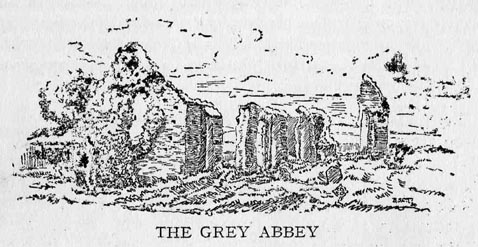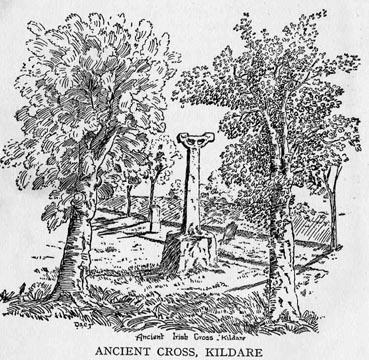« February 2006 |
Main
| April 2006 »
March 26, 2006
AN TOSTAL SOUVENIR PROGRAMME 1953 - CHAPTER 11
THE GREY ABBEY
THE GREY ABBEY has its name from the grey habit worn by the Franciscan Friars. Lord William de Vesci built the monastery for the Friars in 1260. Later the lands of Kildare passed to John Fitzthomas and so to the Earls of Kildare.
The monastery was supported by alms and a special gratuity from the king. For many years the monks were Normans but gradually Irish aspirants were accepted. The monastery had property around the immediate vicinity and in Shanacloon. The Friars, as in every other monastery, lived a life of work and prayer.
Being specially under the protection of the Geraldines, the heads of this family had their tomb in the monastery chapel. The Earls of Kildare were buried in this tomb in the Chapel of the Blessed Virgin up to the beginning of the 17th century. The monastery then ceased to exist although guardians were appointed by the Franciscans up to the year 1729.
At a Chapter of Friars Minor held in Dublin in 1717, Father Anthony Higgins, S.T.L., was elected Guardian (cf. Father Anthony Higgins, P.P., Caragh, who died 1831). Father Christopher Warren was elected Guardian in 1729.
In the early 17th century, between 1620-1635, Brother Michael O’Clery, one of the Four Masters, spent a month in the Grey Abbey collecting and copying Irish manuscripts and history.
The monastery was suppressed about 1543 and its lands and buildings and valuables confiscated and granted to Daniel Sutton. Some of their property seems to have been overlooked, for in 1589 the remainder was confiscated.
The buildings gradually fell into disrepair and by the year 1792, although a portion of the walls remained, all the architectural features were lost. Some ancient sculptured stones were taken from there for safety and inserted in the wall of the White Abbey Church where they are still to be seen. The ivy-clad walls show where the Abbey once stood.
[I’m not sure what the cf – cross reference here to Fr. Higgins of Caragh means; was it a note from one of the authors to suggest both men were related – this cf note is later used in the chapter on the parish priests but in reverse – again without explanation – Mario Corrigan]
Chapter 11 of the An Tostal Programme of 1953 was dedicated to the history of the Grey Abbey.
Posted by mariocorrigan at 06:32 PM
March 20, 2006
AN TOSTAL SOUVENIR PROGRAMME 1953 - CHAPTER 10
TULLY ABBEY
THE TEMPLARS who lived at Tully were monk soldiers organised to assist pilgrims on their way to the Holy Land and to protect the Places sacred to Christians which were in danger from the Mahommedan Infidels. Their first foundation was in the Temple of Solomon in Jerusalem.
The order had four ranks of monks: the armour-clad warrior on horseback with lance and heavy sword; the foot soldier with bow and arrow; the farmer who tilled the land, and the chaplains who ministered to the spiritual wants of the brethren. All members had vows of poverty, chastity and obedience and wore a habit of white with a red cross on the left shoulder. The ensign of the order was a white flag with a black cross. Hence the Abbey was called ‘The Black Abbey.’
The house at Tully which signifies ‘a rising ground’ is dated from 1290 and lasted till its suppression by Henry VIII about the middle of the 16th century. It was an important commandery holding jurisdiction direct from the Pope. It was exempt from taxation and had the right of sanctuary; that is, lawbreakers who found shelter within its precincts could not be molested. It owned upwards of three hundred acres. The order was abolished in 1312 and its property transferred to the Knights of St. John, afterwards called the Knights of Malta. All the property of Tully was confiscated by the crown and the monks dispersed. The tradition for horse-breeding which the monks developed is still preserved close by in the famous National Stud.
About 400 yards north of the Abbey ruins, near Mr. Cashin’s house is St. John’s Well, and was much frequented by Kildare people and other pilgrims up to recent years.
[There is an error here. It was the Knights Hospitallers not the Templars who occupied Tully. The description however of their insignia and their habits is correct - Mario Corrigan]
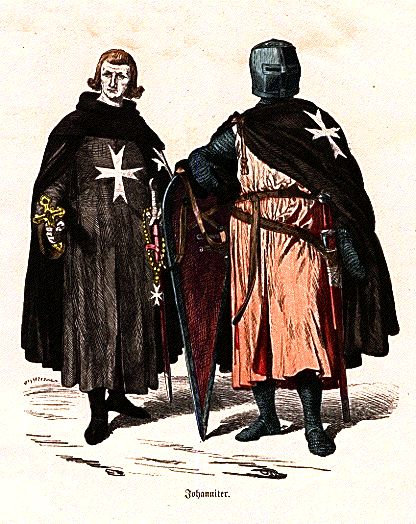 STYLISED IMAGE OF KNIGHTS HOSPITALLERS TAKEN FROM THE INTERNET
STYLISED IMAGE OF KNIGHTS HOSPITALLERS TAKEN FROM THE INTERNET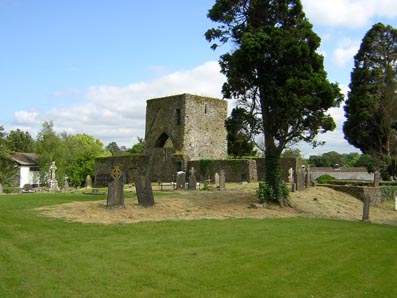 Photo of Tully taken by Mario Corrigan 13 June 2005Chapter 10 of the An Tostal Programme of 1953 is devoted to the Black Abbey at Tully.
Photo of Tully taken by Mario Corrigan 13 June 2005Chapter 10 of the An Tostal Programme of 1953 is devoted to the Black Abbey at Tully.
Posted by mariocorrigan at 09:51 PM
2006 A.G.M. Grey Abbey Conservation Project
An outline of the Agenda - the running order may change
Grey Abbey Conservation Project
A.G.M. Thursday 23 March 7 p.m.
Aras Bhride, Kildare
Agenda:
Minutes of 2005 A.G.M
Election of Officers
Grey Abbey Book Committee
Grey Abbey Monument/Memorial
Grey Abbey Graveyard
Dunmurry Graveyard
Annual Church Gate Collection
Committee Meetings
A.O.B.
Date of next Committee Meeting
The 2006 A.G.M. of the Grey Abbey Conservation Project will take place on Thursday 23 March in the Parish Centre, Aras Bhride. All welcome, particluarly new members.
Posted by mariocorrigan at 04:15 PM
March 12, 2006
AN TOSTAL SOUVENIR PROGRAMME 1953 - CHAPTER 9
THE GERALDINES
THE GERALDINES trace their ancestry to the powerful family of Gherardini of Florence. Maurice Fitzgerald came to Ireland with Strongbow. The family carved out large tracts of land for themselves in Munster, and in Leinster where they dispossesed [dispossessed – sic] the O’Byrnes and O’Tooles and drove them to the Wicklow mountains. Maurice built the Castle of Maynooth, and John Fitzthomas enlarged it in 1426. This same John took the Castle of Kildare from Calvagh O’Connor who had conquered it from De Vesci.
The Earls of Kildare strengthened their power by alliances with the Irish chiefs and by intermarriage with other powerful families. In this way they succeeded in holding their castles and became so powerful that an English king could say of the Great Earl “All Ireland cannot rule this man then let this man rule Ireland.” The Geraldines ruled Ireland as Deputies of the English King. But they became completely irish, speaking the Irish language in their homes, and encouraging native customs. Unlike their rivals the Butlers, they allied themselves with the native chiefs. This was chiefly the reason why Silken Thomas and his five brothers were executed by the English on Tyburn. Thereafter the English Kings appointed Englishmen as their deputies.
In the early seventeenth century Kildare Castle became a refuge for those who refused to accept the Protestant religion. When Gerald, the sixteenth Earl died, his cousin George was brought up a Protestant by the Court of Chancery. So the powerful Geraldine family lost their ancient Faith. The members of this famous house had faded from history for two centuries when English power was again challenged by the noble Lord Edward. lie was the last Geraldine to live in Kildare.
[There seems to be an error here. In the previous chapter the authors say Calvagh O’Connor captured the castle in 1294 and that it was re-taken by the Normans in 1307 so it is unlikely that it was the same John Fitzthomas who enlarged Maynooth in 1426. John Fitzthomas who became 1st Earl of Kildare in 1316 died that same year at Rathangan and was buried at Grey Abbey. Another John succeeded his father Gerald in 1410 and became the 6th Earl of Kildare until he died in 1427 - Mario Corrigan. Spelling and grammar are retained as in the original; mistakes indicated by square brackets and sic - [sic]. ]
<
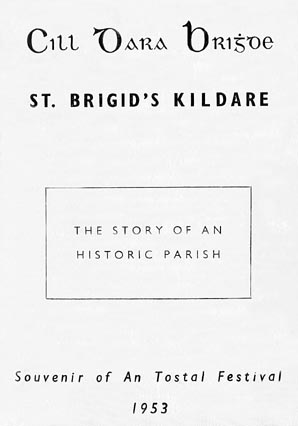
Image of Title Page
Chapter 8 of the An Tostal Programme of 1953 acknowledges the importance of the Fitzgerald family - the Geraldines, Earls of Kildare, some of whom were buried at Grey Abbey Cemetery.
Posted by mariocorrigan at 04:15 PM
March 06, 2006
AN TOSTAL SOUVENIR PROGRAMME 1953 - CHAPTER 8
THE CASTLE OF KILDARE
THE Castle of Kildare was built by William Marshall, Earl of Pembroke, about the beginning of the 13th century. The Earl had married Strongbow’s daughter and so claimed the title, Lord of Leinster.
William built his castle on the Church lands of Kildare, without the Bishop’s consent. Later his descendants were obliged to pay a rent of ten marks to the Bishops of Kildare. If this rent was not paid on the day appointed, the Castle Bailiff was excommunicated until the rent was paid.
In 1294, Calvagh O’Connor captured the Castle and seems to have held it until 1307, when he was defeated and the Castle re-taken by the Normans. The following year Calvagh was treacherously slain by Peter Bermingham.
In 1316, the Castle was granted by Edward II to Thomas Fitzgerald, whom he also created Earl of Kildare, in recognition of his services to the King during the Bruce Invasion, 1315-1318.
Through the piety of Elizabeth, Countess of Kildare, the Castle became a home and refuge for persecuted Catholics in the early 17th century.
About the year 1540 the Castle was burned by O’Connor. In 1643 it was repaired and a garrison established there. In 1647, Col. Jones captured it but shortly afterwards it was retaken by the Irish, who held it until 1649. Subsequently it was the residence of the Fitzgerald family. The last member of the family to reside there was the patriotic and brave Lord Edward. At present one tower of the once famous Castle is all that remains.
[Lord Edward lived in a Lodge in the area known as the People’s Park near the remaining tower; not in the Castle itself. This Lodge disappeared from maps of the town in the early 19th century. It was possibly demolished shortly after the 1798 Rebellion. – Mario Corrigan]
Chapter 8 of the An Tostal Programme tells the story of the Castle of Kildare.
Posted by mariocorrigan at 09:33 PM
